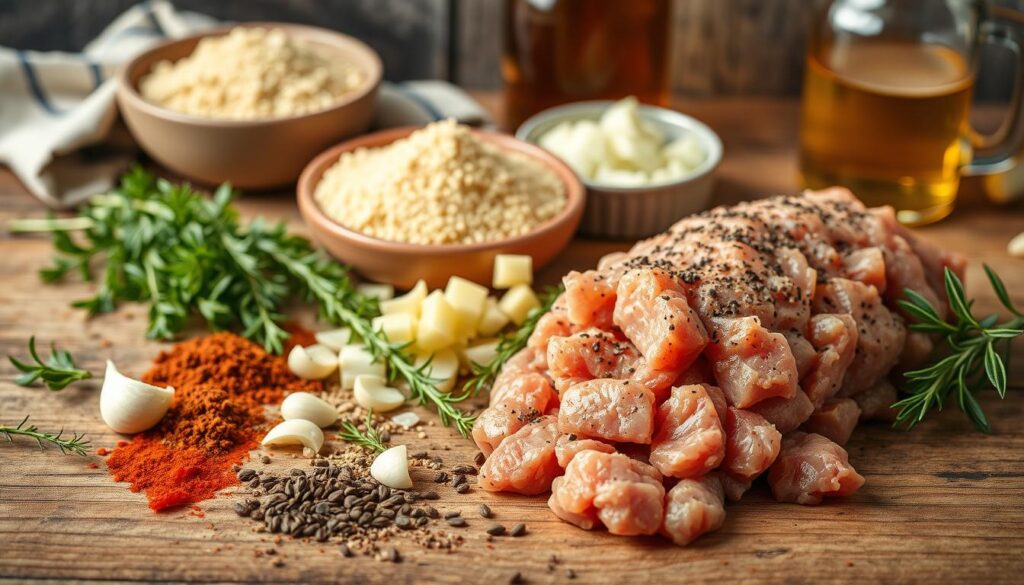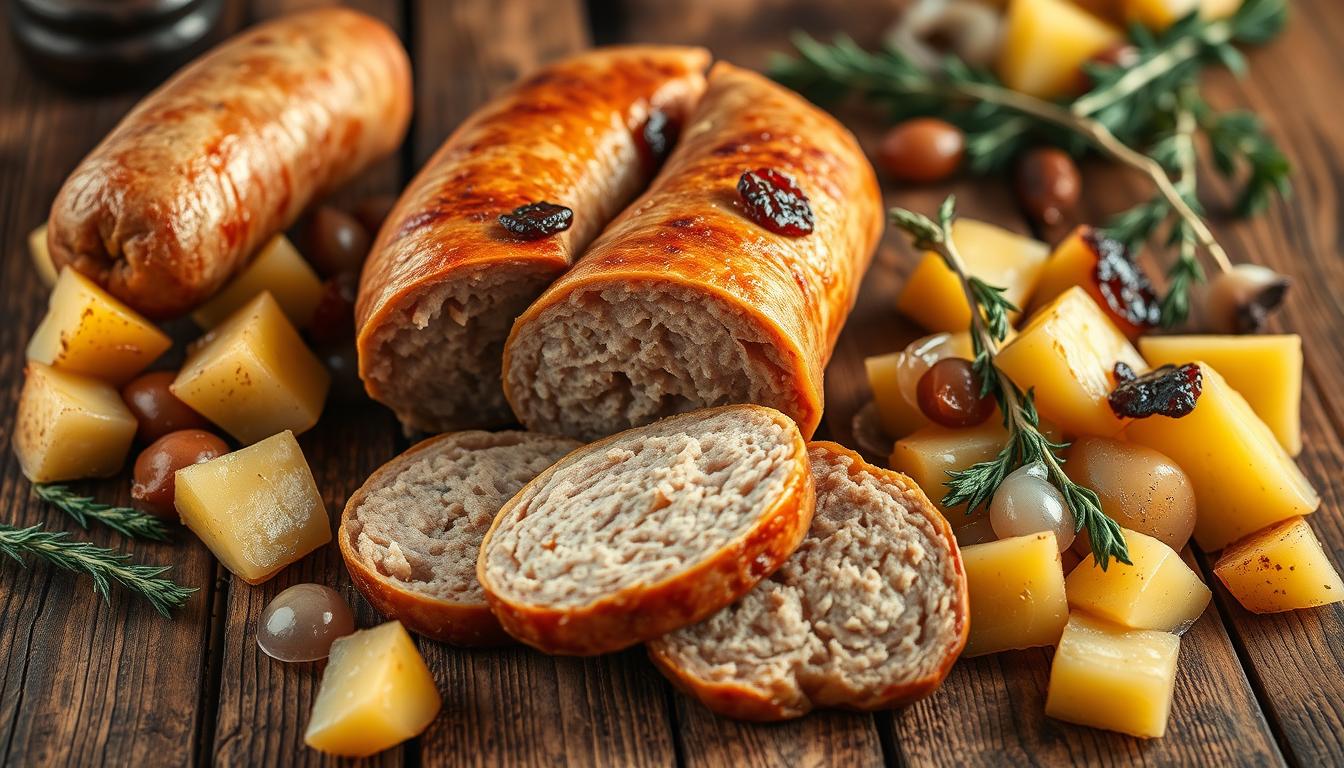
Creating a potato sausage recipe connects you to your family’s past. I remember my grandmother making homemade sausage that brought us all together. The smell of seasoned pork and potatoes filled our home, making unforgettable memories.
This recipe is more than food; it’s about comfort, heritage, and the joy of cooking. Whether you’re a pro or just starting, you’ll love making this dish. Our guide will help you make a homemade sausage that will become a favorite in your kitchen.
Table of Contents
The History and Heritage of Traditional Potato Sausage
Potato sausage is a tasty journey across continents and through time. It comes from European cooking, especially in Scandinavian cuisines. There, families made and shared their potato and sausage recipes for years.

The tale of potato sausage shows how immigrants adapted their cooking. When Europeans came to America, they changed their sausage recipes to use local ingredients.
European Culinary Foundations
In Europe, potato sausage was a filling meal. Families made their own versions using local potatoes and meat. These dishes helped workers get through long days.
- Scandinavian regions pioneered early potato sausage techniques
- German and Polish culinary traditions significantly influenced recipe development
- Preservation methods were crucial in creating long-lasting sausage varieties
American Culinary Evolution
When potato recipes came to America, home cooks started to try new things. Rural areas and farming communities took to these traditions. They used local meat and ingredients to make their own versions.
Regional Family Traditions
Every region had its own potato sausage way. The Midwest, with many European immigrants, kept the old ways alive. This kept the potato recipes alive for future generations.
The heart of potato sausage lies not just in its ingredients, but in the stories and memories shared around the dinner table.
Essential Ingredients for Perfect Potato Sausage

Making tasty potato sausage starts with picking the right ingredients. Your ground pork recipes will stand out with top-notch parts that bring out deep, real flavors. Knowing the key ingredients is crucial for making a fantastic pork sausage that will wow your loved ones.
The base of any great potato sausage is premium ground pork. Aim for meat with 20-30% fat for juicy and tasty results. Your choice of pork is vital for the dish’s success.
- Meat Selection: Lean ground pork from the shoulder or butt works best
- Potato Variety: Russet or Yukon Gold potatoes recommended
- Seasonings: Fresh herbs and traditional spices
Your spice mix is key to adding flavor depth. Classic potato sausage recipes often include:
- Kosher salt
- Black pepper
- Garlic powder
- Nutmeg
- Marjoram
When making your pork sausage, think about texture and moisture. Grated potatoes add structure and a special feel that makes this dish unique.
Pro tip: Always use fresh, high-quality ingredients for the most authentic and delicious potato sausage experience.
Kitchen Tools and Equipment You’ll Need
Making homemade sausage needs the right tools. Whether you’re new or experienced, the right equipment makes the process better and more fun.
Start your sausage making journey by getting the essential kitchen tools. These tools will change your cooking experience.
Basic Equipment Essentials
- Large mixing bowl for ingredient preparation
- Sharp chef’s knife for precise meat cutting
- Cutting board dedicated to meat preparation
- Kitchen scale for accurate measurements
- Meat grinder or food processor
Optional Tools for Advanced Preparation
For better homemade sausage, consider special equipment.
- Sausage stuffer
- Casings presser
- Digital meat thermometer
- Vacuum sealer
Sausage Making Supplies
Special supplies help make your sausage making more professional and precise.
| Supply | Purpose | Recommended for |
|---|---|---|
| Natural hog casings | Traditional sausage wrapping | Authentic texture |
| Spice blender | Creating custom seasoning mixes | Flavor enthusiasts |
| Sausage pricker | Removing air bubbles | Professional results |
“The right tools transform good cooking into great culinary art.” – Chef’s Wisdom
Quality tools make your homemade sausage making better and more fun.
Step-by-Step Potato Sausage Recipe
Making the perfect potato sausage recipe needs careful steps and attention. Your homemade sausage will be a tasty journey. It mixes old techniques with new flavors.
Before you start, get all your ingredients and tools ready. This makes cooking smoother and helps you get the best results.
- Prepare your ingredients:
- 2 pounds ground pork
- 1 pound peeled and diced potatoes
- Kosher salt
- Black pepper
- Garlic powder
- Paprika
- Mixing the meat and potatoes:
- Combine ground pork in a large mixing bowl
- Add finely diced potatoes
- Mix seasonings thoroughly
- Sausage preparation steps:
- Blend ingredients until well-combined
- Use sausage stuffer for uniform texture
- Fill casings carefully
When making your potato sausage recipe, consistency is key. Make sure all ingredients are mixed well for the best taste.
Pro tip: Keep meat and ingredients cold during preparation to maintain optimal texture.
Cooking times depend on your choice. You can grill, pan-fry, or bake your sausages. Cook them until they reach an internal temperature of 160°F.
Tips for Selecting the Best Potatoes and Meat
Creating tasty potato and ground pork recipes starts with picking top-notch ingredients. The taste and feel of your sausage depend on the potatoes and meat you choose. Knowing how to pick the right ingredients can turn a simple dish into a memorable meal.
Choosing the best ingredients means paying close attention and knowing what makes them quality.
Potato Variety Selection
Not all potatoes are the same when making sausage. Look for potatoes with certain qualities:
- Waxy texture for better binding
- Medium starch content
- Firm consistency
Here are some top potato varieties:
- Yukon Gold – Creamy texture
- Red Bliss – Keeps moisture well
- Fingerling – Unique taste
Meat Quality Guidelines
For ground pork, focus on these key points:
- Fat content between 20-30%
- Fresh, bright pink color
- Minimal liquid in packaging
- Clean, fresh smell
Quality Indicators to Examine
Experts suggest these checks:
- Press potato flesh – should feel firm
- Check meat’s marbling
- Verify freshness dates
- Inspect packaging integrity
By choosing your ingredients wisely, your potato and ground pork sausage will have amazing flavor and texture.
Seasoning Secrets and Flavor Combinations
Making the perfect pork sausage starts with seasoning. The right mix of spices and herbs can turn your homemade sausage into something special. It’s all about finding the right balance to bring out the meat’s natural flavors.
Traditional potato sausage seasonings usually include:
- Nutmeg
- White pepper
- Allspice
- Garlic powder
- Salt
When making your own sausage, try these tips:
- Begin with classic spices
- Try different herb blends from around the world
- Adjust the salt and pepper to your liking
- Add a bit of unexpected spice for fun
Experts say to aim for a flavor that complements the meat, not overpowers it. A good seasoning mix should make the meat taste even better, not hide its natural taste.
| Flavor Profile | Key Spices | Recommended Use |
|---|---|---|
| Traditional | Nutmeg, White Pepper | Classic Potato Sausage |
| Spicy | Cayenne, Red Pepper Flakes | Bold Sausage Variations |
| Herbal | Sage, Thyme | Rustic Countryside Style |
Seasoning is a personal journey. Feel free to try new things and create your own unique flavor. It’s a way to show off your cooking skills.
How to Store and Preserve Your Homemade Sausage
Mastering sausage making is just the start. Proper storage is key to keep your homemade breakfast sausage fresh and tasty. Learning the right ways to preserve it will let you enjoy it for weeks or months.
Proper storage begins with knowing the basics of food preservation. Your freshly made sausage needs careful handling to avoid spoilage and keep its great taste.
Short-Term Storage Strategies
For eating right away, store your homemade sausage in an airtight container in the fridge. Here’s what to do:
- Wrap sausages individually in butcher paper or plastic wrap
- Place in a sealed container
- Consume within 3-4 days for optimal freshness
- Keep refrigerator temperature below 40°F
Freezing Your Sausage
Freezing is a great way to keep your sausage for a long time. Here’s how to freeze it right:
- Wrap each sausage tightly in freezer paper
- Place wrapped sausages in freezer-safe bags
- Remove as much air as possible to prevent freezer burn
- Label with the date of freezing
- Store at 0°F or below for up to 3 months
Vacuum Sealing Tips
Vacuum sealing is the most advanced way to preserve your sausage. This method removes air completely, preventing oxidation and freezer burn.
- Use food-grade vacuum sealing bags
- Seal sausages individually or in small batches
- Mark the date and contents on each sealed package
- Vacuum-sealed sausages can last up to 6 months in the freezer
By using these storage methods, your homemade sausage will stay delicious and safe to eat. This way, you’ll keep enjoying the results of your sausage making skills.
Serving Suggestions and Pairing Ideas
Your homemade potato sausage is ready for a creative presentation. Whether it’s a weekend brunch or a hearty breakfast, these ideas will make your meal special.
Classic pairings can make your meal stand out. Try these tasty combinations:
- Scrambled eggs with fresh herbs
- Crispy hash browns or roasted potato wedges
- Warm buttermilk pancakes with maple syrup
- Fresh garden salad with light vinaigrette
For a brunch that wows, make a sausage-centered charcuterie board. Slice your potato sausage thin and add:
- Artisan cheeses
- Pickled vegetables
- Whole grain mustard
- Crusty sourdough bread
Drinks can also boost your potato sausage’s flavor. Here are some great options:
- Freshly brewed coffee
- Bloody Mary
- Sparkling mimosa
- Craft beer with robust flavor
Your potato sausage can be the star of many meals. From a quick breakfast to a fancy brunch, these ideas will make your dining memorable.
Troubleshooting Common Issues While Making Potato Sausage
Making sausage can be tricky, especially for first-timers. Even seasoned cooks face challenges. Knowing common problems helps make perfect sausages every time.
Texture Troubles
When your sausage is dry or crumbly, several things might be wrong. Here are some fixes:
- Use fresh, high-quality ground meat with enough fat
- Keep the right meat-to-potato ratio (70% meat, 30% potato)
- Mix everything well for even distribution
Casing and Filling Challenges
Working with casings needs precision. For filling or stuffing issues, try these tips:
- Soak natural casings in water to make them more flexible
- Keep the meat cold to avoid separation
- Use a good sausage stuffer for better results
Fat-Related Issues
Too much fat can mess up your sausage. Here’s how to handle it:
- Pick lean meat cuts with some marbling
- Trim off extra fat before grinding
- Try mixing pork and beef for a balanced taste
With practice and these tips, you’ll get better at making sausage. You’ll impress everyone with your tasty potato sausages.
Popular Variations of the Basic Recipe
Exploring different potato recipes can turn the classic potato sausage into exciting new dishes. Your basic recipe is a great base for many breakfast meat recipes. These can fit various diets and tastes.
Home cooks can easily change the traditional potato sausage to meet different needs and tastes. You can make it spicier, plant-based, or lighter. These changes will make your cooking more fun and diverse.
Spicy Version
For those who love bold flavors, making a spicy potato sausage is easy. Just add hot paprika, crushed red pepper flakes, or diced jalapeños to the meat mix. These will make your breakfast meat recipes more exciting while keeping the dish’s core.
Vegetarian Alternative
Plant-based cooks can use textured vegetable protein or a mix of mushrooms like portobello and shiitake. These give a meaty texture and rich flavor, making the dish vegetarian.
Low-Fat Options
For those watching their fat intake, you can use lean ground turkey or chicken instead of pork. You don’t have to lose flavor. With the right seasoning and preparation, your low-fat potato sausage will still be tasty.
FAQ
What makes potato sausage different from traditional sausage?
Potato sausage is special because it mixes finely grated potatoes with the meat. This makes it more moist and tender than regular sausage. It has a unique flavor and softer texture, thanks to the potatoes.
Can I make potato sausage if I don’t have a sausage stuffer?
Yes, you can! You don’t need a sausage stuffer to make potato sausage. You can shape it into patties or a loose meat mixture. For links, use a funnel or a piping bag to fill casings.
What are the best potatoes to use in potato sausage?
Use starchy potatoes like Russet or Idaho for the best results. They grate well and add moisture. Make sure to squeeze out extra moisture to avoid a wet sausage.
How long can I store homemade potato sausage?
Store it in an airtight container in the fridge for 3-4 days. For longer storage, freeze it for up to 3 months. Wrap it tightly in freezer-safe packaging to avoid freezer burn.
Is it possible to make a vegetarian version of potato sausage?
Absolutely! Use plant-based ground alternatives like TVP, Beyond Meat, or Impossible Foods. Choose spices that match the traditional flavor to get a similar taste.
What spices are typically used in traditional potato sausage?
Traditional potato sausage uses salt, black pepper, allspice, and sometimes nutmeg. These spices give it a rich, Scandinavian flavor that goes well with pork and potatoes.
Can I make potato sausage without pork?
Yes, you can use ground turkey, chicken, or beef instead of pork. Each will change the flavor slightly. Ground turkey is a good choice for a leaner option.
How fine should I grate the potatoes for potato sausage?
Grate the potatoes finely using a box grater or food processor. Then, squeeze out excess moisture with a towel or cheesecloth. This keeps the sausage from being too wet.

